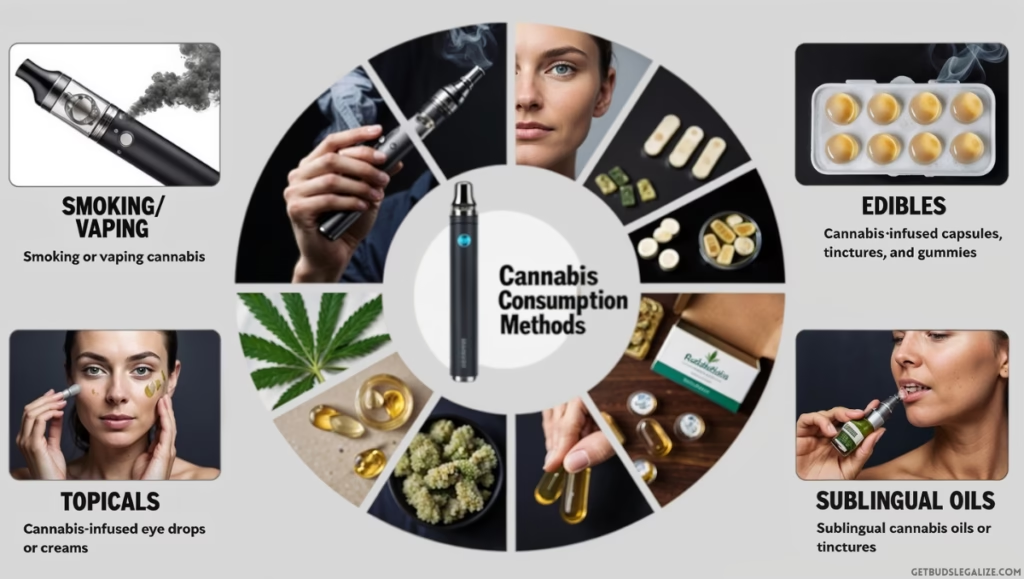The Power of Cannabis for Glaucoma Treatment: A Comprehensive Guide to Treatment and Benefits
Glaucoma, often referred to as the “silent thief of sight,” is one of the leading causes of blindness worldwide, affecting millions. Traditional glaucoma treatments, such as eye drops and surgery, can sometimes fail to offer adequate relief or come with significant side effects. As a result, many patients are turning to alternative treatments, including cannabis, to manage their condition.
Cannabis has gained attention for its potential to reduce intraocular pressure (IOP)—the primary factor in glaucoma progression—and may help preserve vision in patients with the disease.
In this comprehensive guide, we will explore how medical cannabis can benefit glaucoma patients, the scientific mechanisms behind its effects, the various consumption methods, and how it can be incorporated into your treatment plan.
What is Glaucoma and How Does It Affect Eyes?
Glaucoma refers to a group of eye conditions that damage the optic nerve, often due to elevated intraocular pressure (IOP). If left untreated, this damage can result in irreversible vision loss.
The most common type is primary open-angle glaucoma (POAG), which develops gradually and may go unnoticed until significant damage has occurred.
IOP increases when the eye’s drainage system becomes blocked, leading to fluid buildup that pressures the optic nerve.
Types of Glaucoma:
- Open-Angle Glaucoma (POAG): This type progresses slowly and often has no noticeable symptoms in the early stages.
- Angle-Closure Glaucoma: This type occurs suddenly and is marked by a rapid increase in IOP, causing painful symptoms and a medical emergency.
- Normal-Tension Glaucoma: Despite normal IOP levels, optic nerve damage occurs, potentially due to factors other than elevated pressure.

Can Cannabis Help in Glaucoma?
Yes, cannabis, particularly its active compounds THC (tetrahydrocannabinol) and CBD (cannabidiol), has shown promising potential for managing glaucoma by lowering intraocular pressure (IOP). Cannabis works by increasing the eye fluid’s outflow or reducing its production. While not a cure for glaucoma, cannabis can be an adjunctive therapy to help manage IOP levels and prevent further optic nerve damage.
Several studies suggest that THC is particularly effective in lowering IOP, often within minutes of consumption. However, its effects are relatively short-lived, lasting about 3-4 hours.
On the other hand, CBD appears to have a more complex effect, not directly lowering IOP, but providing neuroprotective benefits and reducing some of the adverse effects associated with THC.
Cannabis and Glaucoma Studies
Several studies have explored the effects of cannabis on IOP, with promising results:
- The 1970s Study: One of the first studies to demonstrate that THC could reduce IOP significantly—by up to 25%—within 30 minutes of consumption.
- Recent Clinical Trials: More recent studies have confirmed these early findings, supporting the use of cannabis, particularly THC, as an effective short-term treatment for lowering IOP. However, due to its short duration of action, cannabis may not be suitable as a long-term solution for daily treatment.
While THC is most effective for IOP reduction, CBD does not directly lower IOP but may help protect the optic nerve and offer neuroprotective effects, especially in preventing damage from elevated pressure over time.

Effective Ways to Consume Cannabis for Glaucoma Treatment
Cannabis can be consumed in various forms to manage glaucoma symptoms. The ideal form depends on personal preference, lifestyle, and specific needs. Below, we discuss the most common consumption methods:
1. Smoking or Vaping
Smoking or vaping cannabis is one of the quickest ways to feel the effects, as the active compounds are absorbed through the lungs and into the bloodstream almost immediately. This provides fast relief for elevated IOP.
However, smoking can irritate the lungs, leading many patients to prefer vaping, which is considered a cleaner alternative.
2. Edibles
Edibles, such as cannabis-infused capsules, tinctures, and gummies, provide a convenient method of consumption without the need for inhalation.
While the onset of effects is slower (30 minutes to 2 hours), edibles offer longer-lasting relief, making them suitable for consistent symptom management throughout the day.
3. Topicals
Cannabis-infused eye drops or creams are designed to target the eye directly, providing localized relief. These options are ideal for those who want to avoid the systemic effects of smoking or ingesting cannabis, as they work directly at the site of concern.
However, their effectiveness may vary compared to other forms of cannabis.
4. Sublingual Oils
Sublingual cannabis oils or tinctures are absorbed quickly when placed under the tongue, providing relief within 15-30 minutes.
This method offers a balance between the rapid onset of smoking and the longer-lasting effects of edibles, making it a popular choice among patients.

How to Incorporate Cannabis into Your Glaucoma Treatment Plan
If you’re considering cannabis as part of your glaucoma management plan, it’s crucial to work closely with your healthcare provider. Here’s a step-by-step guide to help you get started:
- Consult a Doctor: Not all forms of cannabis are suitable for everyone, especially for those who are already on prescription glaucoma medications. Consult with a physician experienced in treating glaucoma with cannabis to discuss whether it is an appropriate option for you.
- Choose the Right Form: Depending on your preferences, lifestyle, and health considerations, select a cannabis consumption method that works best for you. Whether smoking, vaping, edibles, or topicals, it’s important to find the method that fits your daily routine and goals.
- Start Low and Go Slow: When introducing cannabis into your treatment plan, start with a low dose and gradually increase it. This approach will help you gauge your tolerance and minimize the risk of side effects.
- Monitor Intraocular Pressure Regularly: Regular checkups with your ophthalmologist are essential while using cannabis for glaucoma management. Your doctor will monitor your IOP and ensure that your treatment plan is effective, including any adjustments in dosage or combination with other glaucoma medications.
Potential Side Effects and Risks of Using Cannabis for Glaucoma
While cannabis is generally well-tolerated, it can cause side effects, particularly when used in large amounts. THC may lead to dizziness, dry mouth, altered mental states, and, in some cases, an increased heart rate. For individuals with cardiovascular concerns, this could be problematic.
CBD, on the other hand, is generally more tolerable, though it may interact with certain medications, including those commonly used for glaucoma.
Always consult your healthcare provider before incorporating cannabis into your treatment.

Historical Context: Cannabis in Medicine Through the Ages
Cannabis has been used for medicinal purposes for thousands of years, with ancient civilizations recognizing its therapeutic potential. This history provides valuable context for its modern use in treating glaucoma.
- Ancient Egypt: The Ebers Papyrus (1550 BCE) mentions “Shemshemet,” believed to be cannabis, for its anti-inflammatory properties, including potential applications for eye conditions.
- Ancient China: The Shennong Bencaojing (300 AC) describes cannabis for pain and inflammation relief, which may have helped with eye pressure management, an early precursor to its use in treating glaucoma.
- Indian Ayurveda: Cannabis, known as “bhang,” was widely used in ancient India for pain relief, inflammation, and vision disorders. Texts like the Atharvaveda (1200 BCE) highlighted its calming and therapeutic properties.
- Broader Influence: As cannabis spread through trade, it was incorporated into medicinal practices in Mesopotamia, Greece, and Rome. Ancient Roman texts, like those of Pliny the Elder, noted its use for pain and swelling relief, further establishing its broad therapeutic potential.
Connecting History to Modern Applications:
While ancient texts did not directly mention glaucoma, their use of cannabis for eye-related conditions and pain management laid the foundation for its contemporary exploration in glaucoma treatment.
Conclusion: Is Cannabis the Right Choice for You?
Cannabis offers significant promise for reducing intraocular pressure (IOP) and managing glaucoma symptoms. While it is not a cure for glaucoma, it can be a valuable part of a comprehensive treatment strategy to prevent further vision loss.
If you’re considering cannabis as an option, it is important to consult with your healthcare provider to determine whether it’s right for you, monitor its effects, and integrate it with your current treatment regimen.
With the proper guidance and monitoring, cannabis may provide a new avenue for managing glaucoma and preserving vision.
Frequently Asked Questions about Using Medicinal Marijuana for Glaucoma Treatment
Glaucoma is primarily caused by an increase in intraocular pressure (IOP), which damages the optic nerve. IOP occurs when the fluid inside the eye (aqueous humor) does not drain properly, causing a buildup of pressure. The exact cause of this blockage can vary:
- Genetics: A family history of glaucoma increases the likelihood of developing the condition.
- Age: People over 60 are at higher risk of developing glaucoma.
- Eye injury or trauma: Damage to the eye can block the drainage of fluid and increase pressure.
- Certain medical conditions: Conditions like diabetes, high blood pressure, and hypothyroidism can increase the risk of developing glaucoma.
- Long-term use of corticosteroids: These medications can increase IOP and increase the likelihood of developing glaucoma.
Cannabis, particularly THC (tetrahydrocannabinol), works by either increasing the outflow of fluid from the eye or reducing its production. Both of these mechanisms contribute to lowering intraocular pressure (IOP).
By lowering IOP, cannabis can help protect the optic nerve from further damage caused by high pressure, potentially slowing the progression of glaucoma.
No, cannabis cannot cure glaucoma. It can, however, effectively lower IOP and manage the symptoms, reducing the risk of vision loss.
Cannabis should be used as part of a comprehensive treatment plan in combination with prescribed medications and regular eye care to prevent further optic nerve damage.
The best method depends on your personal preferences and health needs. Smoking and vaping provide quick relief since the cannabinoids are absorbed directly into the bloodstream through the lungs.
Edibles and sublingual oils, on the other hand, provide longer-lasting effects but take longer to take effect (up to 2 hours).
Work with your doctor to determine the most appropriate form based on your individual needs and treatment goals.
While cannabis is generally safe for most people, its long-term effects on IOP and glaucoma progression are not fully understood.
It can provide temporary relief, but it is not a permanent solution. Regular eye exams and consultations with your healthcare provider are essential to monitor your condition and ensure the best course of treatment.
Several strains of cannabis are known for their potential to lower IOP. Indica-dominant strains are often preferred due to their calming effects and the potential to reduce eye pressure. Popular strains include:
- ACDC (high CBD, low THC)
- Harlequin (balanced THC/CBD ratio)
- Granddaddy Purple (Indica, high THC)
These strains are typically recommended for those who seek relief without intense psychoactive effects. Always consult with your healthcare provider before trying new strains.
In addition to cannabis, several lifestyle changes and medical treatments can help manage glaucoma:
- Prescription eye drops: Commonly used to lower IOP.
- Regular eye check-ups: Monitoring IOP and the health of the optic nerve is crucial.
- Exercise: Regular physical activity can help lower IOP.
- Dietary changes: Foods rich in antioxidants, such as leafy greens, may support eye health.
For glaucoma, Indica-dominant strains are often recommended. These strains are known for their calming and relaxing effects, which may be beneficial for reducing intraocular pressure and promoting overall relaxation.
Sativa strains, on the other hand, tend to be more energizing and may not be as effective for lowering IOP.
However, some patients may prefer a hybrid strain that balances both Indica and Sativa effects.
Always consult your doctor to determine which strain is right for you.
The two most prominent cannabinoids used for glaucoma are THC and CBD:
- THC is the primary compound responsible for lowering IOP, making it the most effective cannabinoid for glaucoma treatment. However, its psychoactive effects may not be desirable for all patients.
- CBD does not directly lower IOP, but it has neuroprotective properties and may help with inflammation and overall eye health. A balanced ratio of THC to CBD may offer the best benefits for glaucoma patients. Discuss with your doctor which cannabinoid or combination would work best for you.
Glaucoma can worsen due to several factors, including:
- Increased intraocular pressure (IOP): If pressure inside the eye rises and is not managed, it can damage the optic nerve.
- Lack of treatment: Not following prescribed treatments or missing regular eye check-ups can lead to further damage.
- Poor medication adherence: Skipping or stopping prescribed eye drops or other treatments can allow IOP to rise.
- Certain medications: Some drugs, like corticosteroids, can increase IOP and worsen glaucoma.
- Health conditions: Uncontrolled diabetes, high blood pressure, or other systemic issues can contribute to glaucoma progression.
Maintaining consistent treatment and regular eye exams is crucial to managing glaucoma effectively.
Yes, cannabis can be used alongside traditional glaucoma medications to help lower intraocular pressure (IOP), but it should not replace prescribed treatments.
It’s important to work with a healthcare provider to develop a plan that combines cannabis with other therapies for effective IOP management.
Cannabis can lower IOP temporarily (3–4 hours), but it is not a long-term solution for glaucoma.
It is typically used as an adjunct to more reliable treatments like eye drops or surgery.
Consult a healthcare provider to create a treatment plan that includes cannabis if appropriate.
Yes, cannabis for glaucoma treatment can be effective in lowering intraocular pressure (IOP) and offering temporary relief.
However, it should be used in conjunction with other treatments such as prescribed eye drops and regular monitoring of eye health.
Discuss with your healthcare provider to determine the best approach for managing your glaucoma symptoms with cannabis.
ILGM Fertilizer

- From seedling to harvest, give your plants everything they need.
- Enough for feeding at least 5 plants.
- Discounted Package Deal
- Works well in soil, hydroponics, and other growing mediums.
- The best way to treat your plants
ILGM Plant Protector

- Protect your cannabis from diseases and harmful pests.
- Contains three 20 ml bottles.
- Enough supplies to protect 20 plants.
- It can be used in soil, hydroponic, and all other growing mediums.





















